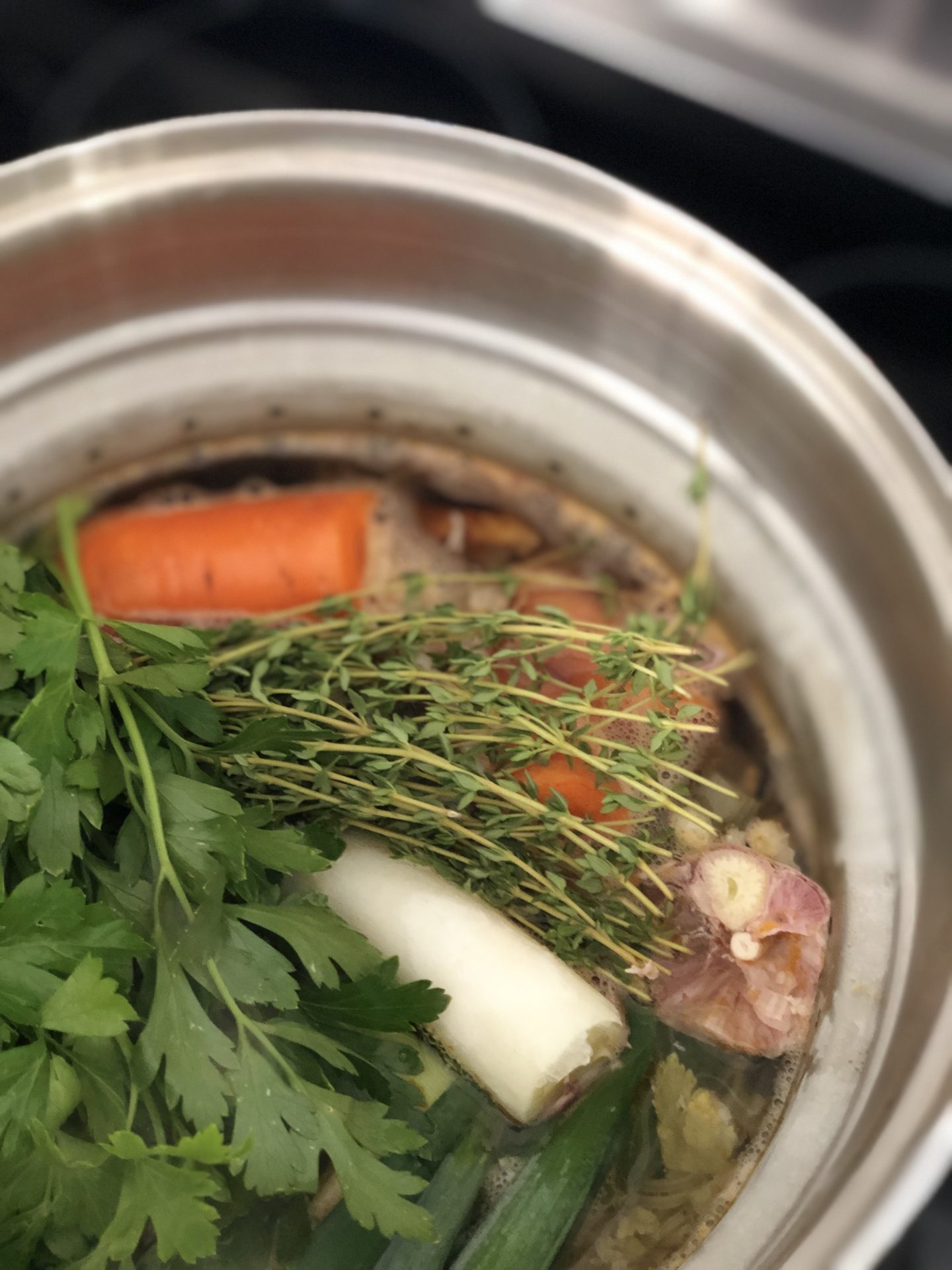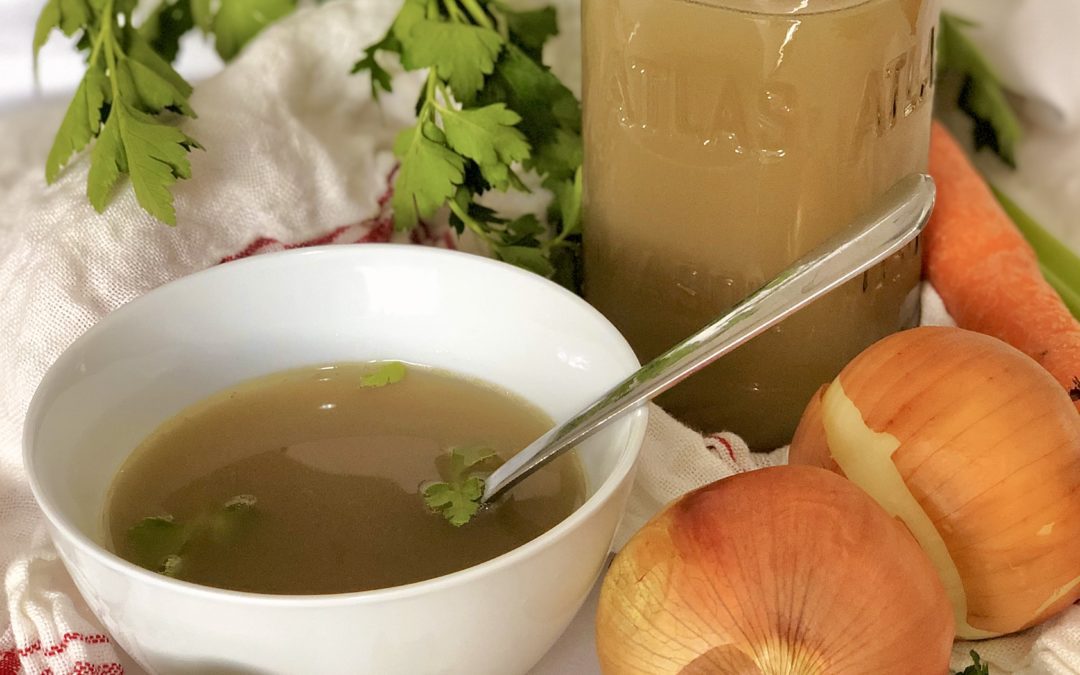If you want to become a better cook, this is a great place to start. A flavourful chicken stock is a building block for many recipes, and can mean the difference between a good meal and a really great one. Do you have the bones and trimmings left from a roast chicken? One with the lovely little bits of chicken still clinging to it? Instead of throwing it away, give it new purpose by simmering it with a few pantry staple vegetables and herbs to make a fragrant stock that will pay dividends whether you use it now or freeze it for later.
While it’s a bit of an unusual ingredient in a stock recipe, I like to add whole cloves. Don’t worry, they won’t leave your stock tasting like a spice cake. Instead, they lend a bit of warmth and add a savoury depth to the stock. If you’re unsure about it, just leave them out. Or try just one or two the first time, then build up to 3 or 4 later and you’ll see that it’s not at all overpowering and adds welcome dimension.
As usual, at the bottom of the recipe, I’ve included tips and explanations in the Recipe Notes section. It’s always worth a read to understand the reasons why things are done a certain way, and for a few key ideas for how to make things better. My biggest tip for making chicken stock is to use a large pasta pot with a straining insert as your stock pot . Straining your finished stock can be a hot, greasy job. Instead of pouring your hot stock through a colander into bowl, simply lift the pasta insert out and allow the hot stock to strain back into the pot. It dirties fewer dishes, but more importantly it is a much safer way of handling a large quantity of hot liquid. If you don’t have a large pasta pot with a straining insert, and you’d like to add one to your collection, look for one with a heavy bottom, deep insert and capacity of 7L-8L (7.5qt-8.5qt).
Click here to link to the one that I use.
Simple Golden Chicken Stock
Time: 3.5 hours (3 hours of inactive time) Yield: makes 8 cups
INGREDIENTS
- About 1kg/2.2lbs of any combination of chicken bones with bits of meat and skin attached or chicken wings, legs or backs (I often use the carcasses of 2 grocery store rotisserie chickens)
- 2 yellow cooking onions, unpeeled, root end trimmed and cut in quarters
- 2 celery stalks, cut in chunks (or equivalent amount of smaller inner stalks and leaves)
- 1 carrot, scrubbed clean, unpeeled, stem end trimmed and cut in chunks
- 1 head of garlic, unpeeled, root end trimmed to expose cloves
- 1 small bunch of fresh parsley
- 1 tsp whole black peppercorns
- 4 whole cloves (optional)
- 1 Tbsp kosher salt
- optional add ins: a chopped leek, a scrubbed and unpeeled parsnip, small bunches of fresh thyme or dill, 1-2 bay leaves
INSTRUCTIONS
Combine all ingredients in a large pasta pot with straining insert, or in a large stock pot. Cover with 12 cups of cold water and bring to a boil. Simmer gently, partially covered, until reduced by one-third, about 3 hours. Strain the contents by lifting out the insert from the pasta pot, or strain through a colander into a large bowl if using a regular stock pot. Discard the solids. Chill the broth overnight and remove the hardened fat from the surface the next day. Use right away or pack into containers and freeze for up to 3 months.
RECIPE NOTES
- This is a recipe for stock not broth, so what’s the difference? They’re similar, but the difference comes down to what goes in the pot. With broth, it’s usually just meat and/or vegetables, simmered in a liquid, which produces a lighter, thinner solution. Stock is made with bones, in addition to meat and vegetables, which results in a deeply flavoured, more substantial liquid. The bones, cartilage and skin of the chicken release collagen and gelatin which give stock its rich body and texture (and make it extra good for you!)
- The golden colour of this stock is enhanced by the yellow onion skins, so be sure they make it into the pot!
- You can peel the carrots (and parsnip if using) if you’d like, but there’s really no need. I wash them well, trim the tops, chop them into a few pieces and toss them into the pot
- There’s no need to separate and peel the garlic cloves. Cut off the root end to expose the cloves and add it in whole.
- Start with cold water for a more transparent stock. Using warm or hot water won’t effect the taste, but will result in a cloudier stock.
This website is a participant in the Amazon Associates program, an affiliate marketing program designed to provide a means for sites to earn fees by advertising and linking to Amazon.ca or Amazon.com.



